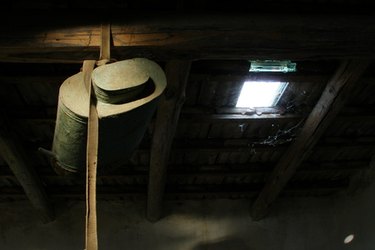
Spray foam insulation is a popular method of providing a greater R-value -- insulation value -- per inch than conventional fiberglass batts. However, if it's not properly installed, spray foam can cause some problems. Badly installed spray foam may not insulate properly, can cause moisture problems, encourage insect infestations and even irritate the lungs of people living in the house.
Voids
Video of the Day
Improperly applied spray foam often contains voids, where the foam does not completely cover. According to Ask the Builder, voids can greatly reduce the material's R-value per inch. To avoid empty spaces in your spray foam insulation, have it installed by an experienced professional with the right equipment. Attempting to apply spray foam on your own increases the chance of problems.
Video of the Day
Deterioration
Older spray foam insulations such as UFFI (urea formaldehyde foam insulation) may crumble and break down over time. This soft material is quite fragile and easy to damage during normal household activities. Disintegrating UFFI produces fine airborne particles that can become respiratory irritants. Some people with chemical sensitivities and existing respiratory illnesses may also be sensitive to gases produced by UFFI. Newer spray foam insulation, such as Icynene, does not crumble as easily and presents less of a respiratory hazard.
Insects
Foam board and spray insulation can increase the risk of infestation by termites, carpenter ants and other wood-boring or eating insects. These insects easily tunnel through foam materials, especially when they're in contact with wooden framing elements. To prevent your foam insulation from encouraging insect infestation, install an approved chemical or physical insect barrier before applying the foam. In buildings with existing foam insulation, termite shields, termiticides and regular anti-termite building maintenance can reduce the chances of this problem.
Moisture
Incorrectly installed spray foam insulation can trap moisture in the home, encouraging rot and mold problems. Applying an even sheet of foam to the underside of a roof or other space can eliminate the routes that water vapor uses to leave the house. Over time, trapped moisture can cause serious problems. Choose open-cell spray foam when insulating roofs, since closed-cell foam can trap water from a leaking roof, damaging the framing material and roof sheathing.
- Inspectapedia: How to Identify Icynene Foam Urethane Foam, Isocyanurate Foam Building Insulation Products & Their Propertie
- Ask the Builder; Foam Insulation; Tim Carter
- Inspectapedia: How to Distinguish Among UFFI, Icynene & Latex Foam Building Insulation
- Inspectapedia: Insect Damage & Foam Building Insulation Products: Termites, Carpenter Ants, Contaminants
- Inspectapedia: How to Identify UFFI - Urea Formaldehyde Building Insulation